We use cookies to make your experience better. To comply with the new e-Privacy directive, we need to ask for your consent to set the cookies. Learn more
High End Ukuleles at SUS Part One
The subtle differences between the high end ukulele brands at the Southern Ukulele Store. Part One
We get calls daily asking us to objectively compare ukuleles of different types and brands and although we welcome this enquiry, it can be very difficuilt not to play favourites when you get to come to work everyday and stare at the most beautifully built high end instruments. What makes a Kanile'a different from a Mele and a KoAloha different to a Big Island? What makes a Hawaiian built Koa instrument different to a US or Japanese instrument? Lets start with some K brands.
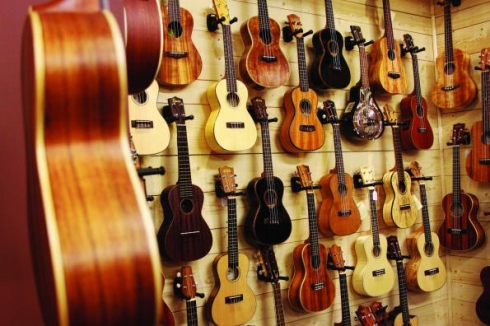 Kanile'a
Kanile'a were the first Hawaiian built instruments I played when I started working at SUS. If you are buying a Kanile'a you can expect an instrument made with just the most beautiful Koa wood. It doesn't seem to matter if its a standard K1 or a K4 deluxe - Kanile'a instruments always look striking whilst staying understated and sounding fantastic. The satin finishes have a lovely low end boom to them when you fingerpick and the gloss ukuleles have a cheeky tightness to their sound in the formative months you play them in, before the wood really opens. It is in the years after you purchase a Kanile'a that it really starts to mature with the player.
Kanile'a are probably the most innovative of the Hawaiian companies and certainly in my experience the most enthusiastic about what they make and sell. Don't take my word for it, go on Kanile'a's website and contact the head honcho Joe Souza himself with any questions you have and he will find the time to get back to you.
Other more unusual features found with some, if not most, Kanile'a models are a pin bridge instead of a tie on bridge. The explanation behind this is that is improves sustain and intonation and as I have certainly never found a bad example of a Kanile'a you could argue confidently that it works. Kanile'a also often find themselves pioneering new and innovative building techniques such as the ultra violet micro gloss finish that protects the wood and creates an invisible barrier on your instrument at the same time. Some of the very new Kanile'a models we have stocked have been unique and interesting shapes such as Super Tenors and the heart shaped sound hole on the Kuuipo.
Kanile'a
Kanile'a were the first Hawaiian built instruments I played when I started working at SUS. If you are buying a Kanile'a you can expect an instrument made with just the most beautiful Koa wood. It doesn't seem to matter if its a standard K1 or a K4 deluxe - Kanile'a instruments always look striking whilst staying understated and sounding fantastic. The satin finishes have a lovely low end boom to them when you fingerpick and the gloss ukuleles have a cheeky tightness to their sound in the formative months you play them in, before the wood really opens. It is in the years after you purchase a Kanile'a that it really starts to mature with the player.
Kanile'a are probably the most innovative of the Hawaiian companies and certainly in my experience the most enthusiastic about what they make and sell. Don't take my word for it, go on Kanile'a's website and contact the head honcho Joe Souza himself with any questions you have and he will find the time to get back to you.
Other more unusual features found with some, if not most, Kanile'a models are a pin bridge instead of a tie on bridge. The explanation behind this is that is improves sustain and intonation and as I have certainly never found a bad example of a Kanile'a you could argue confidently that it works. Kanile'a also often find themselves pioneering new and innovative building techniques such as the ultra violet micro gloss finish that protects the wood and creates an invisible barrier on your instrument at the same time. Some of the very new Kanile'a models we have stocked have been unique and interesting shapes such as Super Tenors and the heart shaped sound hole on the Kuuipo.
 I own a Kanile'a GL6 Guitalele and still find myself looking at the holographic featured in the wood almost everytime I'm led on the sofa at home playing it.
KoAloha
I love KoAloha. Despite being Hawaiian they envoke all sorts of emotions and sensory thoughts about beaches in California, vintage guitars and surf boards. New KoAloha's sound Gnarled, loud, confident, sexy and sweet.
Gloss KoAloha's are a completely different beast to a Kanile'a. The gloss feels a little waxy and coarse but this compliments the instrument no end. The KoAloha wood can be completely different from one to the other but they almost always have a distinct straightness to the grain and the people sourcing timbre for them have an incredible eye for detail.
I once saw a KoAloha made of purple and green Koa. You don't believe me I can tell, but I swear it happened..
The sound of KoAloha is open and loud whilst never being shrill. My colleagues Paul and Guns own KoAlohas that are a number of years old and they have really begun to come in to their own.
KoAloha's can also be identified by a unique crown headstock but the gem in the crown (get it?) has to be the styles of KoAloha on hand. Papa KoAloha is more than a little bit of a celebrity on the island and some of his unique designs include a Sceptre ukulele, Pineapple sundae and the jukebox uke. There is no denying that these instruments are slightly gimmicky but they defy logic by sounding like instruments worth thousands of pounds.
If you are in the market for a high end ukulele. It is worth looking into KoAloha more closely before making your decision.
I own a Kanile'a GL6 Guitalele and still find myself looking at the holographic featured in the wood almost everytime I'm led on the sofa at home playing it.
KoAloha
I love KoAloha. Despite being Hawaiian they envoke all sorts of emotions and sensory thoughts about beaches in California, vintage guitars and surf boards. New KoAloha's sound Gnarled, loud, confident, sexy and sweet.
Gloss KoAloha's are a completely different beast to a Kanile'a. The gloss feels a little waxy and coarse but this compliments the instrument no end. The KoAloha wood can be completely different from one to the other but they almost always have a distinct straightness to the grain and the people sourcing timbre for them have an incredible eye for detail.
I once saw a KoAloha made of purple and green Koa. You don't believe me I can tell, but I swear it happened..
The sound of KoAloha is open and loud whilst never being shrill. My colleagues Paul and Guns own KoAlohas that are a number of years old and they have really begun to come in to their own.
KoAloha's can also be identified by a unique crown headstock but the gem in the crown (get it?) has to be the styles of KoAloha on hand. Papa KoAloha is more than a little bit of a celebrity on the island and some of his unique designs include a Sceptre ukulele, Pineapple sundae and the jukebox uke. There is no denying that these instruments are slightly gimmicky but they defy logic by sounding like instruments worth thousands of pounds.
If you are in the market for a high end ukulele. It is worth looking into KoAloha more closely before making your decision.
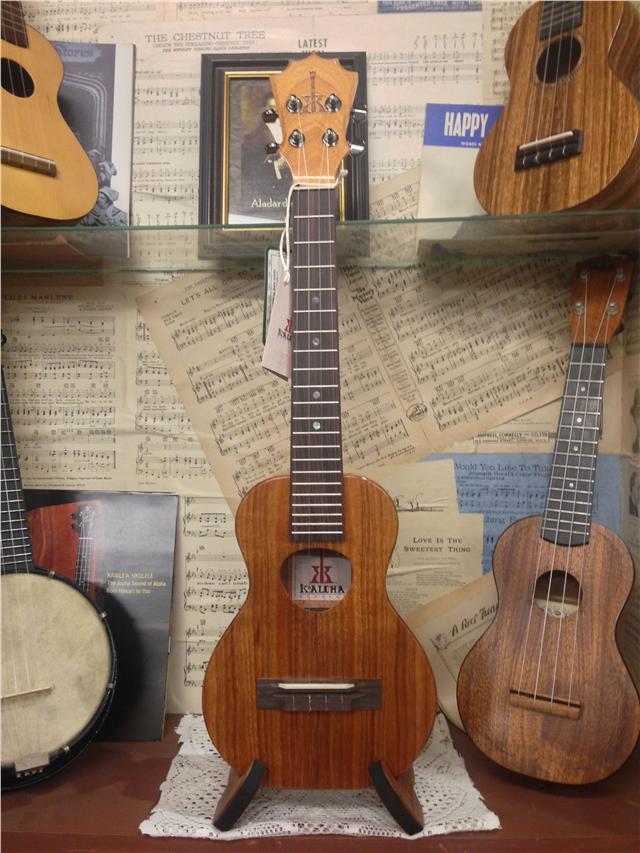 Mele
Mele ukuleles are perhaps a bit of an alternative choice for a high end instrument. They make solid Koa ukuleles, but the models I have had the chance to play have been all solid Mahogany and on a number of occasions cedar top/koa back and sides models.
I wasn't aware until I began to research for this blog (thats right, I do research) that the Mele Mahogany series are more popular in Hawaii than the Koa models and for good reason,
Mele ukuleles have a number of things about them that make them relatively unique in the world of Hawaiian instruments. The first one is the choice of wood. Mahogany sounds darker, more soulful and bluesy than Koa and Mele based these models on the specifications of early Nazareth PA made 1920's Martin ukuleles.
What mele offer is a Hawaiian ukulele at roughly half the price of other things made on the island. The build quality is excellent although sometimes they can be let down by poor finishing. I wouldn't allow that to put you off because the timbre used to make the instrument is as good as it gets. If the icing on a cake was a little bit wonky you would still enjoy eating it and that is Mele.
Richie Williams (UOGB) purchased a Mele baritone from us a couple of years back and has ended up nearly putting holes in the top he plays it so often.. Look them up and look out for our occasional delivery. We are all fans here at SUS.
Mele
Mele ukuleles are perhaps a bit of an alternative choice for a high end instrument. They make solid Koa ukuleles, but the models I have had the chance to play have been all solid Mahogany and on a number of occasions cedar top/koa back and sides models.
I wasn't aware until I began to research for this blog (thats right, I do research) that the Mele Mahogany series are more popular in Hawaii than the Koa models and for good reason,
Mele ukuleles have a number of things about them that make them relatively unique in the world of Hawaiian instruments. The first one is the choice of wood. Mahogany sounds darker, more soulful and bluesy than Koa and Mele based these models on the specifications of early Nazareth PA made 1920's Martin ukuleles.
What mele offer is a Hawaiian ukulele at roughly half the price of other things made on the island. The build quality is excellent although sometimes they can be let down by poor finishing. I wouldn't allow that to put you off because the timbre used to make the instrument is as good as it gets. If the icing on a cake was a little bit wonky you would still enjoy eating it and that is Mele.
Richie Williams (UOGB) purchased a Mele baritone from us a couple of years back and has ended up nearly putting holes in the top he plays it so often.. Look them up and look out for our occasional delivery. We are all fans here at SUS.
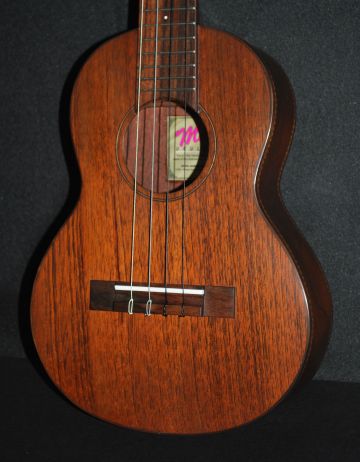 Kiwaya
Lets jump on a plane to Japan and look at Kiwaya.
Kiwaya are distinctly the most clinically built ukuleles we have ever sold. Concentrating on the bread and butter models of the KTS-4 and KTS-7 you could be forgiven for thinking you were looking at the creme de la creme of vintage Martin ukuleles.
Playing a Kiwaya is an experience! The KTS-4, for example, is a no thrills looking Mahogany uke that really rings out and has real presence. Kiwaya almost definately excel at building Soprano ukuleles and if that is the size you have your heart set on, look at Kiwaya first.
Kiwaya
Lets jump on a plane to Japan and look at Kiwaya.
Kiwaya are distinctly the most clinically built ukuleles we have ever sold. Concentrating on the bread and butter models of the KTS-4 and KTS-7 you could be forgiven for thinking you were looking at the creme de la creme of vintage Martin ukuleles.
Playing a Kiwaya is an experience! The KTS-4, for example, is a no thrills looking Mahogany uke that really rings out and has real presence. Kiwaya almost definately excel at building Soprano ukuleles and if that is the size you have your heart set on, look at Kiwaya first.
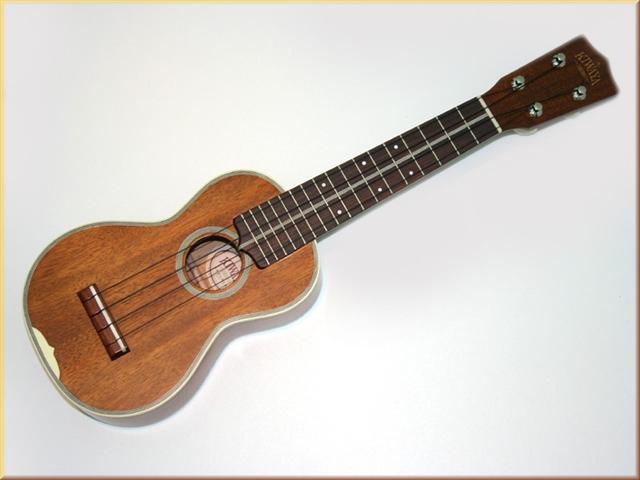 The KMS-K flames Koa ukulele has a much darker character than most of the things you will find from Hawaiian ukulele manufactures. They really aren't being different for the sake of it but instead are producing something with heritage that pushes real boundaries.
So, controversial sweeping statement here - I think the Japanese make better Soprano ukuleles than the Americans (Hawaiians included).
That isn't to say that the Kiwaya concerts and tenors should be ignored. Kiwaya make Concerts and Tenors that look, feel and play like upscaled Sopranos and some mind boggling research into what the Japanese consumer buys will reassure you that this is intentional and probably best for business.
The Japanese ukulele market is so big it is impossible to fathom from our tiny island on the other side of the world and if they like the smaller size ukes then it is fair for Kiwaya to cater more toward their countryman...
The style of manufacture reminds me in many ways of guitar manufacturing and how the necks on my Japanese Fender strat and Epiphone Casino were so much slimmer and flatter than the ones I had played made elsewhere. It is obviously something they are passionate about!
Blackbird
8 hours back on the plane from Tokyo to San Francisco and you get a chance to see an instrument that is a true product of its enviroment. Blackbird currently produce two contrasting ukuleles; The Clara Concert and a Carbonfibre Tenor.
The Clara is an incredibly complex design that promises the world on paper and really does deliver in the flesh. It is made of a material called Ekoa that translated means natural fibres and resin baked together. Some of the more geeky guitarists amongst you will recognise a similar material used as a rosewood substitute on entry level and mid level Martins called Richlite. Naturally, Blackbird have used Richlite on the Fretboard here and you would never think to play the instrument that it was quite so enviromentally friendly. Some might say this ukulele is an Ekoa-Warrior (I am so funny, I know).
The KMS-K flames Koa ukulele has a much darker character than most of the things you will find from Hawaiian ukulele manufactures. They really aren't being different for the sake of it but instead are producing something with heritage that pushes real boundaries.
So, controversial sweeping statement here - I think the Japanese make better Soprano ukuleles than the Americans (Hawaiians included).
That isn't to say that the Kiwaya concerts and tenors should be ignored. Kiwaya make Concerts and Tenors that look, feel and play like upscaled Sopranos and some mind boggling research into what the Japanese consumer buys will reassure you that this is intentional and probably best for business.
The Japanese ukulele market is so big it is impossible to fathom from our tiny island on the other side of the world and if they like the smaller size ukes then it is fair for Kiwaya to cater more toward their countryman...
The style of manufacture reminds me in many ways of guitar manufacturing and how the necks on my Japanese Fender strat and Epiphone Casino were so much slimmer and flatter than the ones I had played made elsewhere. It is obviously something they are passionate about!
Blackbird
8 hours back on the plane from Tokyo to San Francisco and you get a chance to see an instrument that is a true product of its enviroment. Blackbird currently produce two contrasting ukuleles; The Clara Concert and a Carbonfibre Tenor.
The Clara is an incredibly complex design that promises the world on paper and really does deliver in the flesh. It is made of a material called Ekoa that translated means natural fibres and resin baked together. Some of the more geeky guitarists amongst you will recognise a similar material used as a rosewood substitute on entry level and mid level Martins called Richlite. Naturally, Blackbird have used Richlite on the Fretboard here and you would never think to play the instrument that it was quite so enviromentally friendly. Some might say this ukulele is an Ekoa-Warrior (I am so funny, I know).
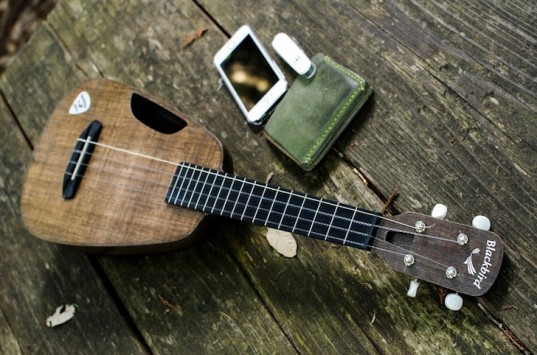 Check out this video on Blackbird ukuleles by the company themselves and take my word for it that everything they promise is true when you have the instrument yourself.
Check out this video on Blackbird ukuleles by the company themselves and take my word for it that everything they promise is true when you have the instrument yourself.
The Carbon fibre ukuleles are a little different but equally interesting. This ukulele is firm to the touch, crisp and clear but with a defined low end suited to a Low G player. You can pick it with your eyes closed and get a sound like a vintage Gibson tenor but when you open it, you see something so intricately designed. The first time I played one I kept thinking it must have been designed by a Formula One racing team because it has that kind of esoteric appeal. If you are a ukulele player and you are planning a trip to Bournemouth to buy a Kanile'a or a KoAloha - at least enquire about this fantastic ukulele. The first one we sold went to a customer that travels the world for work and needed an instrument that could resist the wear and tear of climate and humidity changes not to mention that strong throwing arm of a Virgin Atlantic baggage handler. I think that is probably enough for one sitting. If you have any thoughts on these instruments we would love to hear from you in the comments below. Until next time, Alex Bedrijczuk
 Kanile'a
Kanile'a were the first Hawaiian built instruments I played when I started working at SUS. If you are buying a Kanile'a you can expect an instrument made with just the most beautiful Koa wood. It doesn't seem to matter if its a standard K1 or a K4 deluxe - Kanile'a instruments always look striking whilst staying understated and sounding fantastic. The satin finishes have a lovely low end boom to them when you fingerpick and the gloss ukuleles have a cheeky tightness to their sound in the formative months you play them in, before the wood really opens. It is in the years after you purchase a Kanile'a that it really starts to mature with the player.
Kanile'a are probably the most innovative of the Hawaiian companies and certainly in my experience the most enthusiastic about what they make and sell. Don't take my word for it, go on Kanile'a's website and contact the head honcho Joe Souza himself with any questions you have and he will find the time to get back to you.
Other more unusual features found with some, if not most, Kanile'a models are a pin bridge instead of a tie on bridge. The explanation behind this is that is improves sustain and intonation and as I have certainly never found a bad example of a Kanile'a you could argue confidently that it works. Kanile'a also often find themselves pioneering new and innovative building techniques such as the ultra violet micro gloss finish that protects the wood and creates an invisible barrier on your instrument at the same time. Some of the very new Kanile'a models we have stocked have been unique and interesting shapes such as Super Tenors and the heart shaped sound hole on the Kuuipo.
Kanile'a
Kanile'a were the first Hawaiian built instruments I played when I started working at SUS. If you are buying a Kanile'a you can expect an instrument made with just the most beautiful Koa wood. It doesn't seem to matter if its a standard K1 or a K4 deluxe - Kanile'a instruments always look striking whilst staying understated and sounding fantastic. The satin finishes have a lovely low end boom to them when you fingerpick and the gloss ukuleles have a cheeky tightness to their sound in the formative months you play them in, before the wood really opens. It is in the years after you purchase a Kanile'a that it really starts to mature with the player.
Kanile'a are probably the most innovative of the Hawaiian companies and certainly in my experience the most enthusiastic about what they make and sell. Don't take my word for it, go on Kanile'a's website and contact the head honcho Joe Souza himself with any questions you have and he will find the time to get back to you.
Other more unusual features found with some, if not most, Kanile'a models are a pin bridge instead of a tie on bridge. The explanation behind this is that is improves sustain and intonation and as I have certainly never found a bad example of a Kanile'a you could argue confidently that it works. Kanile'a also often find themselves pioneering new and innovative building techniques such as the ultra violet micro gloss finish that protects the wood and creates an invisible barrier on your instrument at the same time. Some of the very new Kanile'a models we have stocked have been unique and interesting shapes such as Super Tenors and the heart shaped sound hole on the Kuuipo.
 I own a Kanile'a GL6 Guitalele and still find myself looking at the holographic featured in the wood almost everytime I'm led on the sofa at home playing it.
KoAloha
I love KoAloha. Despite being Hawaiian they envoke all sorts of emotions and sensory thoughts about beaches in California, vintage guitars and surf boards. New KoAloha's sound Gnarled, loud, confident, sexy and sweet.
Gloss KoAloha's are a completely different beast to a Kanile'a. The gloss feels a little waxy and coarse but this compliments the instrument no end. The KoAloha wood can be completely different from one to the other but they almost always have a distinct straightness to the grain and the people sourcing timbre for them have an incredible eye for detail.
I once saw a KoAloha made of purple and green Koa. You don't believe me I can tell, but I swear it happened..
The sound of KoAloha is open and loud whilst never being shrill. My colleagues Paul and Guns own KoAlohas that are a number of years old and they have really begun to come in to their own.
KoAloha's can also be identified by a unique crown headstock but the gem in the crown (get it?) has to be the styles of KoAloha on hand. Papa KoAloha is more than a little bit of a celebrity on the island and some of his unique designs include a Sceptre ukulele, Pineapple sundae and the jukebox uke. There is no denying that these instruments are slightly gimmicky but they defy logic by sounding like instruments worth thousands of pounds.
If you are in the market for a high end ukulele. It is worth looking into KoAloha more closely before making your decision.
I own a Kanile'a GL6 Guitalele and still find myself looking at the holographic featured in the wood almost everytime I'm led on the sofa at home playing it.
KoAloha
I love KoAloha. Despite being Hawaiian they envoke all sorts of emotions and sensory thoughts about beaches in California, vintage guitars and surf boards. New KoAloha's sound Gnarled, loud, confident, sexy and sweet.
Gloss KoAloha's are a completely different beast to a Kanile'a. The gloss feels a little waxy and coarse but this compliments the instrument no end. The KoAloha wood can be completely different from one to the other but they almost always have a distinct straightness to the grain and the people sourcing timbre for them have an incredible eye for detail.
I once saw a KoAloha made of purple and green Koa. You don't believe me I can tell, but I swear it happened..
The sound of KoAloha is open and loud whilst never being shrill. My colleagues Paul and Guns own KoAlohas that are a number of years old and they have really begun to come in to their own.
KoAloha's can also be identified by a unique crown headstock but the gem in the crown (get it?) has to be the styles of KoAloha on hand. Papa KoAloha is more than a little bit of a celebrity on the island and some of his unique designs include a Sceptre ukulele, Pineapple sundae and the jukebox uke. There is no denying that these instruments are slightly gimmicky but they defy logic by sounding like instruments worth thousands of pounds.
If you are in the market for a high end ukulele. It is worth looking into KoAloha more closely before making your decision.
 Mele
Mele ukuleles are perhaps a bit of an alternative choice for a high end instrument. They make solid Koa ukuleles, but the models I have had the chance to play have been all solid Mahogany and on a number of occasions cedar top/koa back and sides models.
I wasn't aware until I began to research for this blog (thats right, I do research) that the Mele Mahogany series are more popular in Hawaii than the Koa models and for good reason,
Mele ukuleles have a number of things about them that make them relatively unique in the world of Hawaiian instruments. The first one is the choice of wood. Mahogany sounds darker, more soulful and bluesy than Koa and Mele based these models on the specifications of early Nazareth PA made 1920's Martin ukuleles.
What mele offer is a Hawaiian ukulele at roughly half the price of other things made on the island. The build quality is excellent although sometimes they can be let down by poor finishing. I wouldn't allow that to put you off because the timbre used to make the instrument is as good as it gets. If the icing on a cake was a little bit wonky you would still enjoy eating it and that is Mele.
Richie Williams (UOGB) purchased a Mele baritone from us a couple of years back and has ended up nearly putting holes in the top he plays it so often.. Look them up and look out for our occasional delivery. We are all fans here at SUS.
Mele
Mele ukuleles are perhaps a bit of an alternative choice for a high end instrument. They make solid Koa ukuleles, but the models I have had the chance to play have been all solid Mahogany and on a number of occasions cedar top/koa back and sides models.
I wasn't aware until I began to research for this blog (thats right, I do research) that the Mele Mahogany series are more popular in Hawaii than the Koa models and for good reason,
Mele ukuleles have a number of things about them that make them relatively unique in the world of Hawaiian instruments. The first one is the choice of wood. Mahogany sounds darker, more soulful and bluesy than Koa and Mele based these models on the specifications of early Nazareth PA made 1920's Martin ukuleles.
What mele offer is a Hawaiian ukulele at roughly half the price of other things made on the island. The build quality is excellent although sometimes they can be let down by poor finishing. I wouldn't allow that to put you off because the timbre used to make the instrument is as good as it gets. If the icing on a cake was a little bit wonky you would still enjoy eating it and that is Mele.
Richie Williams (UOGB) purchased a Mele baritone from us a couple of years back and has ended up nearly putting holes in the top he plays it so often.. Look them up and look out for our occasional delivery. We are all fans here at SUS.
 Kiwaya
Lets jump on a plane to Japan and look at Kiwaya.
Kiwaya are distinctly the most clinically built ukuleles we have ever sold. Concentrating on the bread and butter models of the KTS-4 and KTS-7 you could be forgiven for thinking you were looking at the creme de la creme of vintage Martin ukuleles.
Playing a Kiwaya is an experience! The KTS-4, for example, is a no thrills looking Mahogany uke that really rings out and has real presence. Kiwaya almost definately excel at building Soprano ukuleles and if that is the size you have your heart set on, look at Kiwaya first.
Kiwaya
Lets jump on a plane to Japan and look at Kiwaya.
Kiwaya are distinctly the most clinically built ukuleles we have ever sold. Concentrating on the bread and butter models of the KTS-4 and KTS-7 you could be forgiven for thinking you were looking at the creme de la creme of vintage Martin ukuleles.
Playing a Kiwaya is an experience! The KTS-4, for example, is a no thrills looking Mahogany uke that really rings out and has real presence. Kiwaya almost definately excel at building Soprano ukuleles and if that is the size you have your heart set on, look at Kiwaya first.
 The KMS-K flames Koa ukulele has a much darker character than most of the things you will find from Hawaiian ukulele manufactures. They really aren't being different for the sake of it but instead are producing something with heritage that pushes real boundaries.
So, controversial sweeping statement here - I think the Japanese make better Soprano ukuleles than the Americans (Hawaiians included).
That isn't to say that the Kiwaya concerts and tenors should be ignored. Kiwaya make Concerts and Tenors that look, feel and play like upscaled Sopranos and some mind boggling research into what the Japanese consumer buys will reassure you that this is intentional and probably best for business.
The Japanese ukulele market is so big it is impossible to fathom from our tiny island on the other side of the world and if they like the smaller size ukes then it is fair for Kiwaya to cater more toward their countryman...
The style of manufacture reminds me in many ways of guitar manufacturing and how the necks on my Japanese Fender strat and Epiphone Casino were so much slimmer and flatter than the ones I had played made elsewhere. It is obviously something they are passionate about!
Blackbird
8 hours back on the plane from Tokyo to San Francisco and you get a chance to see an instrument that is a true product of its enviroment. Blackbird currently produce two contrasting ukuleles; The Clara Concert and a Carbonfibre Tenor.
The Clara is an incredibly complex design that promises the world on paper and really does deliver in the flesh. It is made of a material called Ekoa that translated means natural fibres and resin baked together. Some of the more geeky guitarists amongst you will recognise a similar material used as a rosewood substitute on entry level and mid level Martins called Richlite. Naturally, Blackbird have used Richlite on the Fretboard here and you would never think to play the instrument that it was quite so enviromentally friendly. Some might say this ukulele is an Ekoa-Warrior (I am so funny, I know).
The KMS-K flames Koa ukulele has a much darker character than most of the things you will find from Hawaiian ukulele manufactures. They really aren't being different for the sake of it but instead are producing something with heritage that pushes real boundaries.
So, controversial sweeping statement here - I think the Japanese make better Soprano ukuleles than the Americans (Hawaiians included).
That isn't to say that the Kiwaya concerts and tenors should be ignored. Kiwaya make Concerts and Tenors that look, feel and play like upscaled Sopranos and some mind boggling research into what the Japanese consumer buys will reassure you that this is intentional and probably best for business.
The Japanese ukulele market is so big it is impossible to fathom from our tiny island on the other side of the world and if they like the smaller size ukes then it is fair for Kiwaya to cater more toward their countryman...
The style of manufacture reminds me in many ways of guitar manufacturing and how the necks on my Japanese Fender strat and Epiphone Casino were so much slimmer and flatter than the ones I had played made elsewhere. It is obviously something they are passionate about!
Blackbird
8 hours back on the plane from Tokyo to San Francisco and you get a chance to see an instrument that is a true product of its enviroment. Blackbird currently produce two contrasting ukuleles; The Clara Concert and a Carbonfibre Tenor.
The Clara is an incredibly complex design that promises the world on paper and really does deliver in the flesh. It is made of a material called Ekoa that translated means natural fibres and resin baked together. Some of the more geeky guitarists amongst you will recognise a similar material used as a rosewood substitute on entry level and mid level Martins called Richlite. Naturally, Blackbird have used Richlite on the Fretboard here and you would never think to play the instrument that it was quite so enviromentally friendly. Some might say this ukulele is an Ekoa-Warrior (I am so funny, I know).
 Check out this video on Blackbird ukuleles by the company themselves and take my word for it that everything they promise is true when you have the instrument yourself.
Check out this video on Blackbird ukuleles by the company themselves and take my word for it that everything they promise is true when you have the instrument yourself.
The Carbon fibre ukuleles are a little different but equally interesting. This ukulele is firm to the touch, crisp and clear but with a defined low end suited to a Low G player. You can pick it with your eyes closed and get a sound like a vintage Gibson tenor but when you open it, you see something so intricately designed. The first time I played one I kept thinking it must have been designed by a Formula One racing team because it has that kind of esoteric appeal. If you are a ukulele player and you are planning a trip to Bournemouth to buy a Kanile'a or a KoAloha - at least enquire about this fantastic ukulele. The first one we sold went to a customer that travels the world for work and needed an instrument that could resist the wear and tear of climate and humidity changes not to mention that strong throwing arm of a Virgin Atlantic baggage handler. I think that is probably enough for one sitting. If you have any thoughts on these instruments we would love to hear from you in the comments below. Until next time, Alex Bedrijczuk
Customer reviews
-
Trustpilot Reviews - Trustpilot Southern Ukulele Store Reviews




